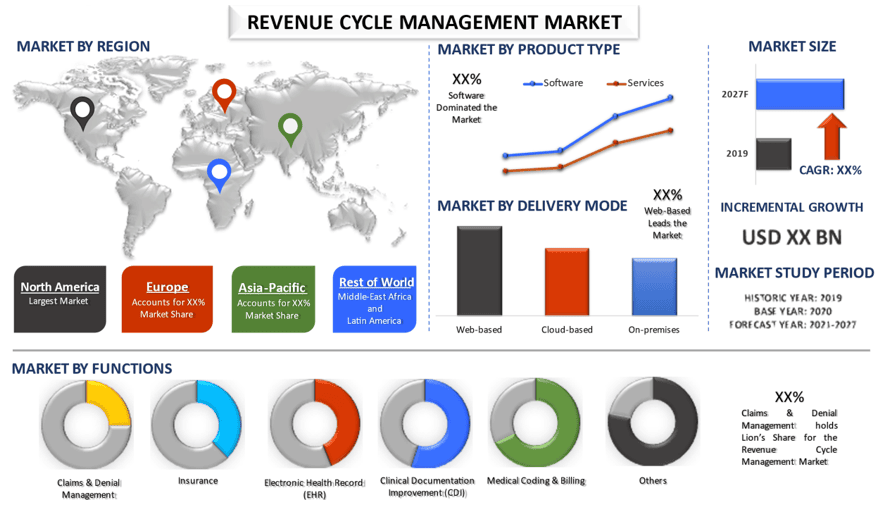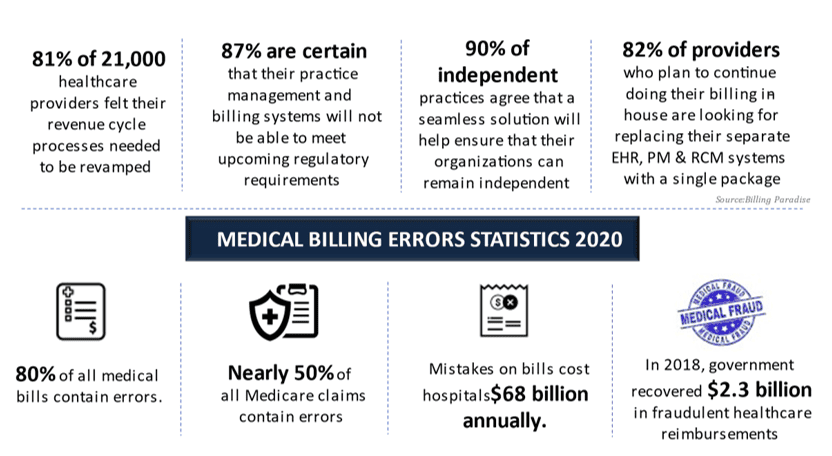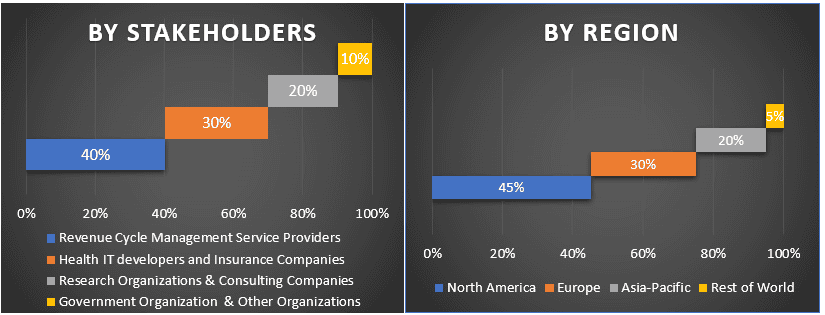- Home
- About Us
- Industry
- Services
- Reading
- Contact Us
Revenue Cycle Management Market: Current Analysis and Forecast (2021-2027)
Emphasis on Functions (Claims & Denial Management, Medical Coding & Billing, Clinical Documentation Improvement, Electronic Health Record, Insurance, and Others); Delivery Mode (On-Premises, Cloud-Based, Web-Based); Product Type (Services, Software); End-Use (Hospitals, Diagnostic Laboratories, Physician’s Offices, Others); Region/Country

Global Revenue Cycle Management Market is anticipated to grow with an elevated CAGR of around 11% over the forecast period (2021-2027). Revenue cycle management is the financial process that utilizes medical billing software and is used in various healthcare facilities to track patient care episodes from registration and appointment scheduling to the final payment of a balance.
The data generated by the healthcare sector is enormous and the need to manage this data is dramatically increasing day by day. Every second, a huge amount of healthcare data is generated, and valuable insights are extracted from it. Currently, around 30% of the world’s data volume is being generated by the healthcare industry and it has been anticipated that by 2025, the compound annual growth rate of data for healthcare will reach 36%. Therefore, to minimize the error rate in this huge bunch of data and to reduce revenue losses, many medical institutions and hospitals are deploying revenue cycle management systems.
Furthermore, the revenue cycle management market is anticipated to grow on account of the growing adoption of integrated healthcare systems including RCM, the rise in the use of healthcare information technology (HCIT), the surge in the number of chronic diseases, and the government initiatives to promote the use of IT in healthcare. For example, The Australian government has taken the initiative to promote healthcare IT in Australia through a lifetime policy PCEHR (Personally Controlled Electronic Health Record) for each of its citizens.
Key Statistics on RCM

McKesson Corporation, Cerner Corporation, Allscripts Healthcare Solutions, GE Healthcare, R1 RCM Inc., eClinicalWorks, Epic Systems Corporation, Athenahealth, Inc., Constellation Software, CareCloud Corporation, are some of the prominent players operating in the revenue cycle management market. Several M&As along with partnerships have been undertaken by these players to facilitate customers with revenue cycle management.
Insights Presented in the Report
“Amongst Functions, Claims & Denial Management segment holds the major share”
Based on functions, the revenue cycle management market is segmented into claims & denial management, medical coding & billing, clinical documentation improvement, electronic health record, insurance, and others. The claims & denial management segment accounted for the largest market share in 2020 and it is estimated that it will exhibit the significant CAGR during the forecast period owing to the launch of advanced RCM solutions. Furthermore, the increase in the revenue because of effective claims management by the adoption of solutions/services for claims and denial management is also one of the prominent factors for the growth of this segment.
“Amongst Delivery Mode, Web-based segment holds the major share”
Based on delivery mode, the revenue cycle management market is segmented into on-premise, cloud-based, and web-based. The web-based segment occupied the major share of the revenue cycle management market in 2020 and it is expected to grow steadily in the upcoming years owing to the growing adoption of solutions such as advanced HIMS, simplex HIMES, e-hospital systems, among others. On the other hand, the cloud-based segment is also projected to grow rapidly during the forthcoming years as they provide high flexibility and are cost-effective for the end-users.
“Amongst Product Type, software segment holds the major share”
Based on product type, the market is fragmented into services and software. In 2020, the software segment grabbed a considerable market share, and it is expected to grow at a significant CAGR during the forecast period owing to the availability of a huge number of technologically advanced software and growing adoption of digital solutions for streamlining better patient care. However, the services segment is also anticipated to show lucrative growth over the projected timeframe. An increase in outsourcing of revenue cycle management services is one of the prominent reasons for the growth of this segment. Furthermore, many of the large pharmaceutical research labs do not have the appropriate resources and skillset required for the deployment of analytics so they outsource these services.
“Amongst End-Use, Physicians Office segment holds the major share”
Based on end-use, the market is fragmented into hospitals, diagnostic laboratories, physician’s offices, and others. In 2020, the physician’s offices segment grabbed a considerable market share, and it is expected to grow at a significant CAGR during the forecast period. The growth of this segment is attributed to the growing number of physicians and rising focus of physicians to implement these systems in their offices. However, the hospitals segment is anticipated to grow at a considerable CAGR during the forecast period.
“North America represents one of the largest markets of revenue cycle management market”
For a better understanding of the market dynamics of the revenue cycle management market, a detailed analysis was conducted for different regions across the globe including North America (the U.S, Canada, and the Rest of North America), Europe (Germany, France, Spain, United Kingdom, Italy, and Rest of Europe), Asia-Pacific (China, India, Australia, Japan, and Rest of APAC), Rest of World has been conducted. North America constitutes a major market for the revenue cycle management market industry and generated revenue of USD XX Million in 2020 owing to strong healthcare infrastructure and growing adoption of advanced technological solutions in the healthcare industry in the region.
Reasons to buy this report:
- The study includes market sizing and forecasting analysis validated by authenticated key industry experts
- The report presents a quick review of overall industry performance at one glance
- The report covers an in-depth analysis of prominent industry peers with a primary focus on key business financials, product portfolio, expansion strategies, and recent developments
- Detailed examination of drivers, restraints, key trends, and opportunities prevailing in the industry
- The study comprehensively covers the market across different segments
- Deep dive regional level analysis of the industry
Customization Options:
The global revenue cycle management market can further be customized as per the requirement or any other market segment. Besides this, UMI understands that you may have your own business needs, hence feel free to connect with us to get a report that completely suits your requirements.
Table of Content
Analyzing the historical market, estimation of the current market, and forecasting the future market of the global revenue cycle management market were the three major steps undertaken to create and analyze the adoption of revenue cycle management in major regions globally. Exhaustive secondary research was conducted to collect the historical market numbers and estimate the current market size. Secondly, to validate these insights, numerous findings and assumptions were taken into consideration. Moreover, exhaustive primary interviews were also conducted, with industry experts across the value chain of the global revenue cycle management market. Post assumption and validation of market numbers through primary interviews, we employed a top-down/bottom-up approach to forecasting the complete market size. Thereafter, market breakdown and data triangulation methods were adopted to estimate and analyze the market size of segments and sub-segments the industry pertains to. Detailed methodology is explained below:
Analysis of Historical Market Size
Step 1: In-Depth Study of Secondary Sources:
Detail secondary study was conducted to obtain the historical market size of the revenue cycle management through company internal sources such as annual report & financial statements, performance presentations, press releases, etc., and external sources including journals, news & articles, government publications, competitor publications, sector reports, third-party database, and other credible publications.
Step 2: Market Segmentation:
After obtaining the historical market size of the revenue cycle management market, we conducted a detailed secondary analysis to gather historical market insights and share for different segments & sub-segments for major regions. Major segments included in the report as functions, delivery mode, product type, and end-use. Further country-level analyses were conducted to evaluate the overall adoption of revenue cycle management across the globe.
Step 3: Factor Analysis:
After acquiring the historical market size of different segments and sub-segments, we conducted a detailed factor analysis to estimate the current market size of the practice management system. Further, we conducted factor analysis using dependent and independent variables such as growing patient volume and advancement in technology propelling the adoption of revenue cycle management. A thorough analysis was conducted for demand and supply-side scenarios considering top partnerships, merger and acquisition, business expansion, and product launches in the revenue cycle management sector across the globe.
Current Market Size Estimate & Forecast
Current Market Sizing: Based on actionable insights from the above 3 steps, we arrived at the current market size, key players in the revenue cycle management market, and market shares of the segments. All the required percentage shares split, and market breakdowns were determined using the above-mentioned secondary approach and were verified through primary interviews.
Estimation & Forecasting: For market estimation and forecast, weights were assigned to different factors including drivers & trends, restraints, and opportunities available for the stakeholders. After analyzing these factors, relevant forecasting techniques i.e., top-down/bottom-up approach was applied to arrive at the market forecast about 2027 for different segments and subsegments across the major markets globally. The research methodology adopted to estimate the market size encompasses:
- The industry’s market size, in terms of value (US$) and the adoption rate of revenue cycle management across the major markets domestically
- All percentage shares, splits, and breakdowns of market segments and sub-segments
- Key players in the revenue cycle management market in terms of products offered. Also, the growth strategies adopted by these players to compete in the fast-growing market
Market Size and Share Validation
Primary Research: In-depth interviews were conducted with the Key Opinion Leaders (KOLs) including Top Level Executives (CXO/VPs, Sales Head, Marketing Head, Operational Head, and Regional Head, Country Head, etc.) across major regions. Primary research findings were then summarized, and statistical analysis was performed to prove the stated hypothesis. Inputs from primary research were consolidated with secondary findings, hence turning information into actionable insights.
Split of Primary Participants in Different Regions

Market Engineering
Data triangulation technique was employed to complete the overall market estimation and to arrive at precise statistical numbers of each segment and sub-segment of the revenue cycle management market. Data was split into several segments & sub-segments post studying various parameters and trends in the areas of functions, product type, delivery mode and end-use of the revenue cycle management market.
The main objective of the Revenue Cycle Management Market Study
The current & future market trends of revenue cycle management were pinpointed in the study. Investors can gain strategic insights to base their discretion for investments from the qualitative and quantitative analysis performed in the study. Current and future market trends were determined the overall attractiveness of the market at a regional level, providing a platform for the industrial participant to exploit the untapped market to benefit as a first-mover advantage. Other quantitative goals of the studies include:
- Analyze the current and forecast market size of revenue cycle management in terms of value (US$). Also, analyze the current and forecast market size of different segments and sub-segments
- Segments in the study include areas of of functions, product type, delivery mode and end-use
- Define and analysis of the regulatory framework for the revenue cycle management industry
- Analyze the value chain involved with the presence of various intermediaries, along with analyzing customer and competitor behaviors of the industry
- Analyze the current and forecast market size of the revenue cycle management market for the major region
- Major regions studied in the report include North America, Europe, Asia-Pacific and Rest of the world
- Company profiles of the revenue cycle management market and the growth strategies adopted by the market players to sustain in the fast-growing market
- Deep dive regional level analysis of the industry
Related Reports
Customers who bought this item also bought










